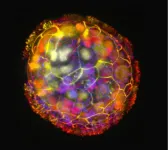(Press-News.org) New research from Northern Arizona University has explained coast redwood’s remarkable ability to recover from very severe fire, a rare sign of optimism amid a landscape increasingly scarred by severe fires.
The study, published today in Nature: Plants, examined recovery after the catastrophic CZU Lightning Complex Fire, which began in August 2020 and burned thousands of acres of redwoods in Big Basin State Park in California, some more than 1,500 years old. Researchers from NAU’s Center for Ecosystem Science and Society (Ecoss) and the School of Informatics, Computing, and Cyber Systems (SICCS) found, however, that many trees were not dead, as they first appeared. Redwoods store massive quantities of carbon reserves, and these reserves fueled growth of new leaves. These leaves sprouted from buried buds that had been dormant for centuries, helping the forest to begin regenerating.
“It remains to be determined if redwood’s old reserves and ancient cell lines are an exception in the plant kingdom or an exceptional example of an insurance strategy common to long-lived plants,” said George Koch, professor in Ecoss and co-author on the study.
Plants store carbon, and many do it for some length of time. Most models looking at these reserves, however, look at a storage period no longer than a year. For a two-millennia-old tree, that doesn’t work. This study modeled how long such reserves could be saved for future use. The researchers inhibited photosynthesis to keep out new carbon and used radiocarbon dating to infer how old the carbon being put to use was. The models suggested that in a few trees, carbon reserves were likely decades—maybe even a century—old.
The team’s updated models showed that the redwoods’ reserves included carbon captured 50 to 100 years ago. “As far as we know, these are some of the oldest carbon reserves ever measured,” said Drew Peltier, assistant research professor in SICCS and lead author on the study. “Sugars photosynthesized perhaps 100 years ago were used to grow new leaves in 2021. Although coast redwood is clearly a superlative species, it is likely that other long-lived trees also harbor carbon reserves that are much older than previously recognized.”
“This study was really exciting for us because we used measurements at the atomic level— counting the amount of carbon-14 relative to carbon-12—to understand what these sprouts, which start as tiny green shoots, are telling us about the growth strategy of these enormous trees, among the largest living organisms on earth,” said Regents’ professor Andrew Richardson, a co-author on the paper.
It's not all good news; many redwoods and trees of other species at Big Basin did not survive the fire. So, although coast redwood is exceptional in its resprouting capacity, it may be centuries until the forest ecosystem at Big Basin has fully recovered.
The other co-authors of the study from NAU are assistant research professor Mariah Carbone; graduate student Melissa Enright and Jim LeMoine.
Watch a video about similar research among the coast redwoods.
END
New study offers cautious hope about the resilience of redwoods
2023-11-30
ELSE PRESS RELEASES FROM THIS DATE:
The American Institute of Biological Sciences aannounces winner of the IDEAL Leadership Award
2023-11-30
The American Institute of Biological Sciences is pleased to announce Dr. Nyeema C. Harris as the 2023 winner of its Inspiring Inclusivity, Diversity, Equity, Acceptance, and Learning (IDEAL) Leadership Award. The IDEAL Award recognizes commendable leadership in advancing inclusion, diversity, equity, acceptance, accessibility, and learning in the biological sciences community. The award was presented by past awardee Dr. Steward T. A. Pickett on 30 November 2023 at AIBS's Council of Member Societies and Organizations meeting, entitled "Expanding the ...
Thomas Fire research reveals that ash can fertilize the oceans
2023-11-30
(Santa Barbara, Calif.) — Flames roared through Santa Barbara County in late 2017. UC Santa Barbara canceled classes, and the administration recommended donning an N95, long before the COVID pandemic made the mask a household item. Smoke and ash choked the air, but the Thomas Fire’s effects weren’t restricted to the land and sky. Huge amounts of ash settled into the oceans, leaving researchers to wonder what effect it might have on marine life.
Now scientists at UC Santa Barbara have discovered that wildfire ash adds nutrients to marine systems, ...
Study tests firefighter turnout gear with, without PFAS
2023-11-30
Transitioning away from per- and polyfluoroalkyl substances (PFAS), which offer water- and oil-repelling properties on the outer shells of firefighter turnout gear, could bring potential performance tradeoffs, according to a new study from North Carolina State University.
The study showed that turnout gear without PFAS outer shell coatings were not oil-repellent, posing a potential flammability hazard to firefighters if exposed to oil and flame, said Bryan Ormond, assistant professor of textile engineering, chemistry and science at NC State and corresponding author of ...
New study uses genetic data to support use of thiazide diuretics for kidney stone prevention
2023-11-30
Kidney stones affect nearly 10% of the global population. For more than three decades, thiazide diuretics, a common medication used for high blood pressure, have been the standard of care for kidney stone prevention because they reduce the excretion of urinary calcium.
However, recent clinical trials have raised doubts about their efficacy in preventing kidney stones. The NOSTONE trial, published in The New England Journal of Medicine in March 2023, failed to find a protective effect of thiazide diuretics on kidney stone disease.
A ...
Study identifies key algae species helping soft corals survive warming oceans
2023-11-30
BUFFALO, N.Y. --- Scleractinian corals, or hard corals, have been disappearing globally over the past four decades, a result of climate change, pollution, unsustainable coastal development and overfishing. However, some Caribbean octocorals, or soft corals, are not meeting the same fate.
During a two-year survey of soft corals in the Florida Keys, Mary Alice Coffroth, professor emerita of geology at the University at Buffalo, along with a small team of UB researchers, identified three species of octocorals that have survived heat waves. While the coral animal itself may be ...
Scientists build tiny biological robots from human cells
2023-11-30
Researchers at Tufts University and Harvard University’s Wyss Institute have created tiny biological robots that they call Anthrobots from human tracheal cells that can move across a surface and have been found to encourage the growth of neurons across a region of damage in a lab dish.
The multicellular robots, ranging in size from the width of a human hair to the point of a sharpened pencil, were made to self-assemble and shown to have a remarkable healing effect on other cells. The discovery is a starting point for the researchers’ vision to use patient-derived ...
Smart microgrids can restore power more efficiently and reliably in an outage
2023-11-30
It’s a story that’s become all too familiar — high winds knock out a power line, and a community can go without power for hours to days, an inconvenience at best and a dangerous situation at worst. UC Santa Cruz Assistant Professor of Electrical and Computer Engineering Yu Zhang and his lab are leveraging tools to improve the efficiency, reliability, and resilience of power systems, and have developed an artificial intelligence (AI) -based approach for the smart control of microgrids for power ...
Unsafe lead levels in school drinking water: new UMass Amherst study IDs building risk factors
2023-11-30
AMHERST, Mass. – University of Massachusetts Amherst civil and environmental engineers have determined the factors that may help identify the schools and daycare centers at greatest risk for elevated levels of lead in drinking water. The most telling characteristic for schools in Massachusetts is building age, with facilities built in the 1960s and 1970s—nearly a third of the facilities tested—at the greatest risk for having dangerously high water lead levels.
There is no safe exposure ...
Chinstrap penguins asleep thousands of times per day, but only for seconds at a time
2023-11-30
In the wild, nesting chinstrap penguins get more than 11 hours of sleep per day – but not all at once. According to a new study, these birds nod off thousands of times per day, but for only around 4 seconds at a time, cumulatively accruing their daily sleep needs while remaining continuously vigilant over their nests. Sleep seems to be ubiquitous throughout the animal kingdom. Typically characterized by immobility and the relative loss of ability to sense and respond to the surrounding environment, sleep can render animals vulnerable to predation. In humans, insufficient sleep can lead to nodding off, the seconds-long interruption of wakefulness by eye closure, and sleep-related ...
A Neptune-mass exoplanet found closely orbiting a very low-mass M dwarf star
2023-11-30
The discovery of a Neptune-mass exoplanet orbiting the very low-mass M dwarf star LHS 3154 challenges theoretical models of planet formation, according to a new study. The planet, which has a mass at least 13 times that of Earth, tightly orbits a star 9 times less massive than the Sun, demonstrating that small stars can sometimes host larger planets than was previously thought. Planets form in the dense circumstellar discs of gas and dust that surround newborn stars. The amount of material in these structures determines how massive the planets that form ...



